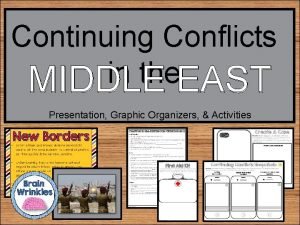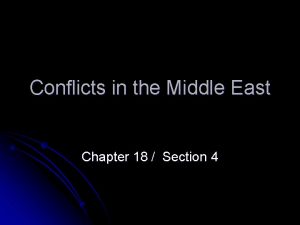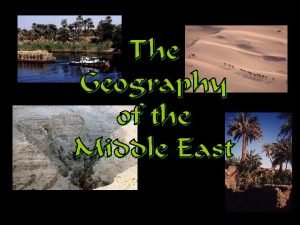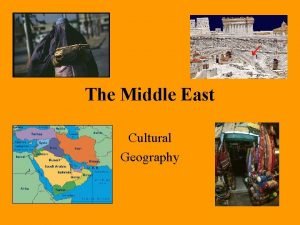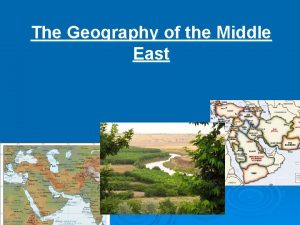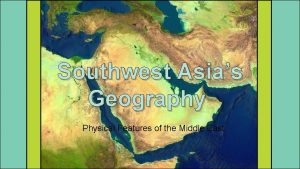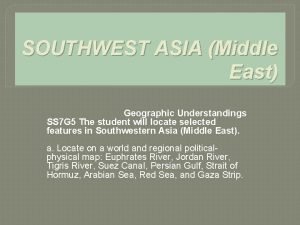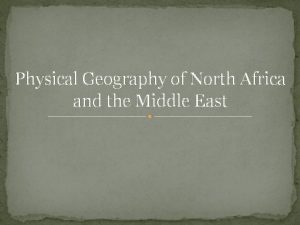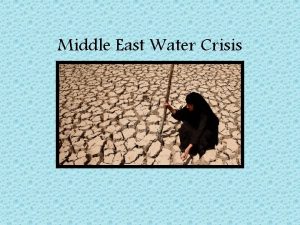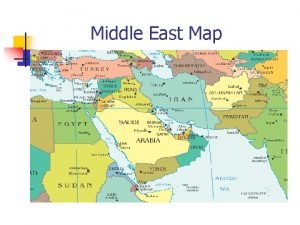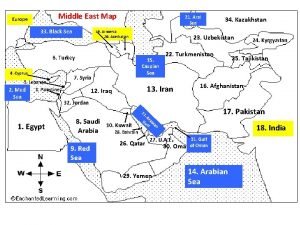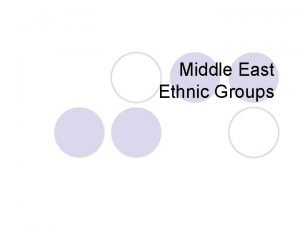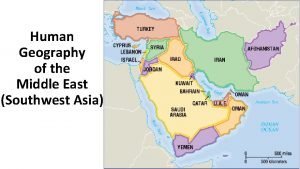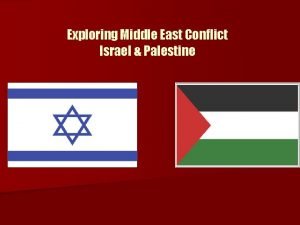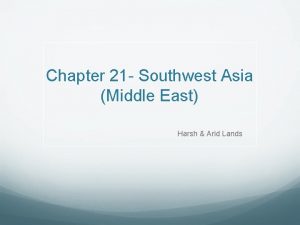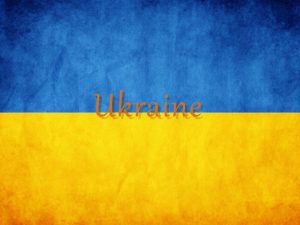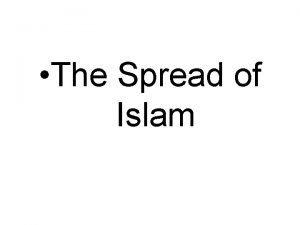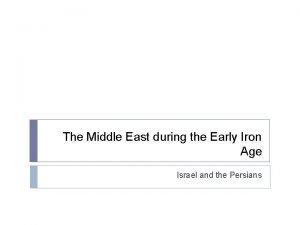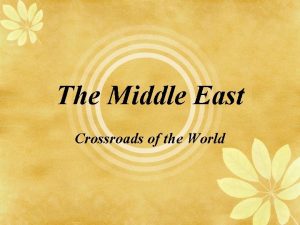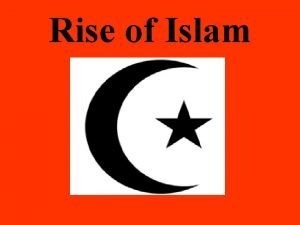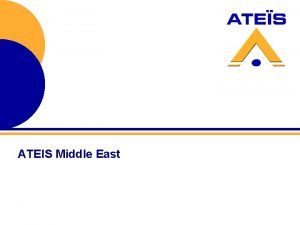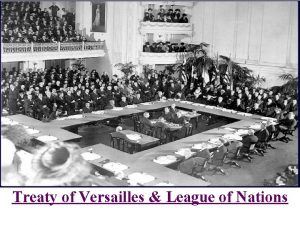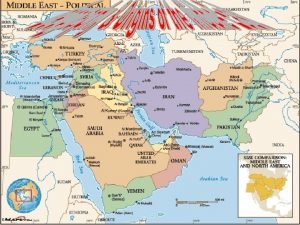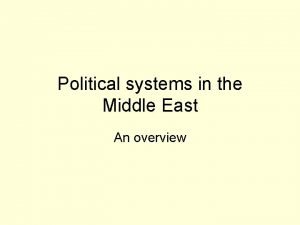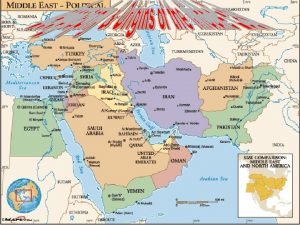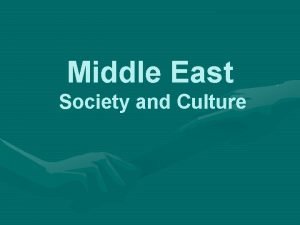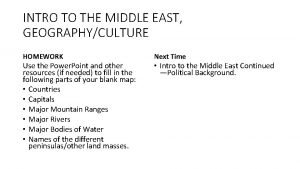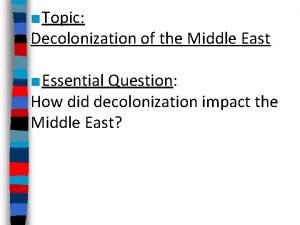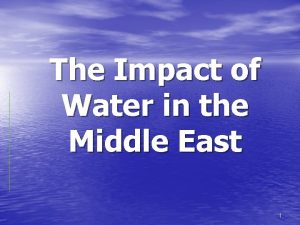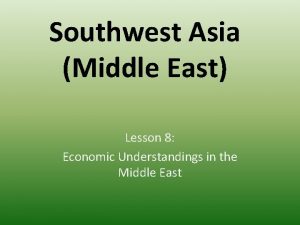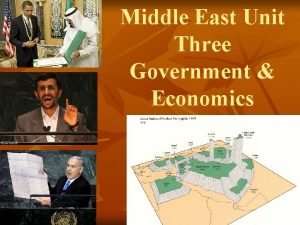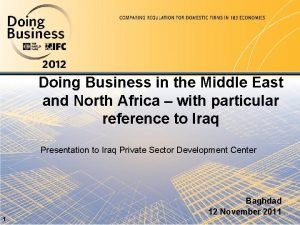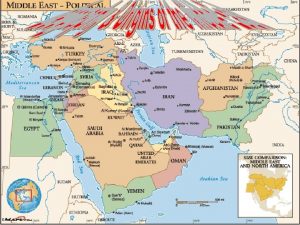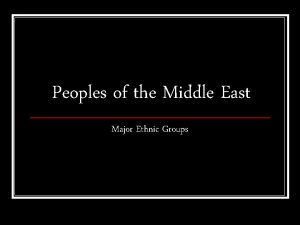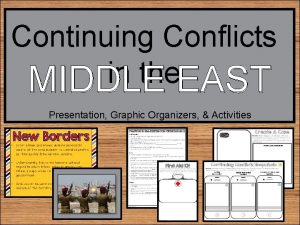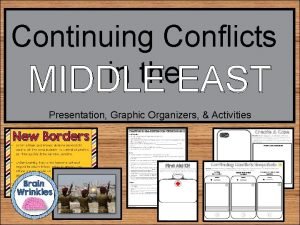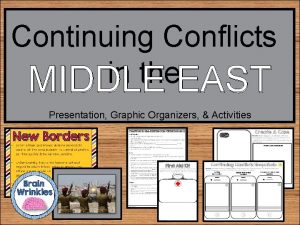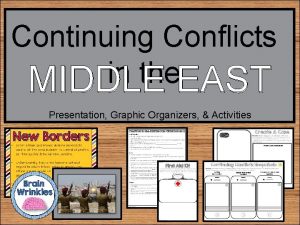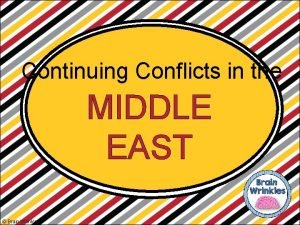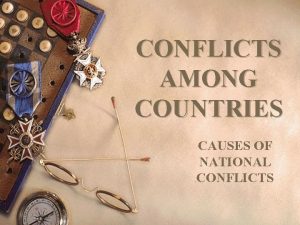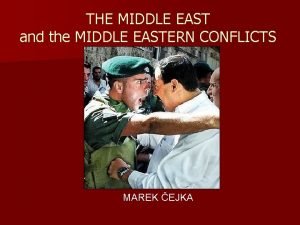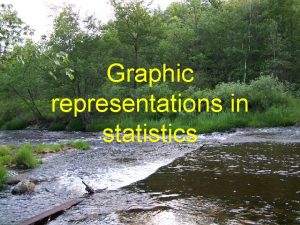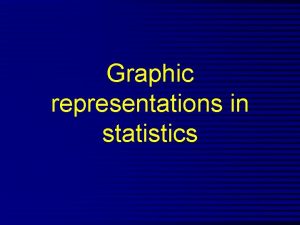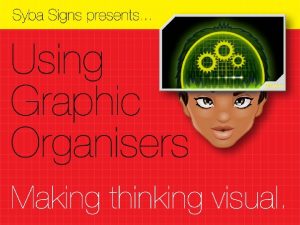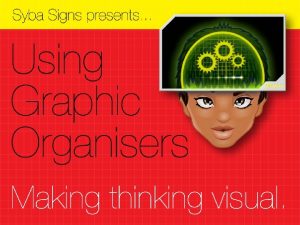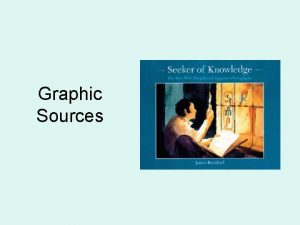Continuing Conflicts in the MIDDLE EAST Presentation Graphic

















































- Slides: 49

Continuing Conflicts in the MIDDLE EAST Presentation, Graphic Organizers, & Activities

Journal Topic: 9/16/19 Caught in the Middle Talk about a time you were caught in the middle of a conflict or disagreement among friends or family and had to be the mediator. Were you able to resolve it? How did it make you feel to be caught in the middle?

Citizenship: School Pride School pride is an essential part of building a successful school community. Students can display school pride by taking ownership in the classroom as well as extracurricular activity. What are some ways students can display school pride?

Journal Topic: 9/17/19 Man vs. Himself Have you ever wrestled with yourself about something! Talk about a time when you had a hard time making a decision that only involved you. What was the resolution?

Citizenship: School Pride School pride is an essential part of building a successful school community. Students can display school pride by taking ownership in the classroom as well as extracurricular activity. Talk about a person who has gone to school with for years who seem to always display school pride. Include details to support your choice.

Journal Topic: 9/18/19 Man vs. Nature Talk about a time when an act of nature (rain, snow, thunderstorm, etc. ) prevented you from doing something that was important to you. How did you feel about?

Journal Topic: 9 -19 -19 Online Bullying Do you know that online bullying is real! What advice would you give to another young person who is a victim of online bullying?

Journal Topic: 9 -20 -19 School Pride School pride is an essential part of building a successful school community. Students can display school pride by taking ownership in the classroom as well as extracurricular activity. Talk about ways that you have personally shown school pride during your tenure at Tutt Middle School. (5 or more complete sentences)

Learning Target: I can explain how European partitioning in the Middle East following WWI led to regional conflict. I can describe how land religion plays a role in continuing conflicts in the Middle East (i. e. the Palestinian-Israeli conflict, the division between Sunni and Shia Muslims, and Kurdish nationalism).

STANDARDS: SS 7 H 2 Analyze continuity and change in Southwest Asia (Middle East). a. Explain how European partitioning in the Middle East following WWI led to regional conflict. c. Describe how land religion plays a role in continuing conflicts in the Middle East (i. e. the Palestinian-Israeli conflict, the division between Sunni and Shia Muslims, and Kurdish nationalism). © Brain Wrinkles

Learning Target: I can explain how European partitioning in the Middle East following WWI led to regional conflict. I can describe how land religion plays a role in continuing conflicts in the Middle East (i. e. the Palestinian-Israeli conflict, the division between Sunni and Shia Muslims, and Kurdish nationalism).

Key Vocabulary: Judaism • Christianity • Islam • mosque • synagogue • Jews • Arabs • Kurds • Persians • Quran • Torah • Bible • Five Pillars of Islam • European partitioning • anti. Semitism • Zionism • Holocaust • Sunni Muslim • Shia Muslim

Conflicts in the Middle East CLOZE Notes 1 Ottoman Empire • The Ottoman Turks were known for their ruthless _____________. • At its height, the Ottoman Empire was six times the _____________. • Its lands stretched from what is now Turkey and parts of southeastern Europe, northern Africa, and _____________. Collapse • Over time, the Ottoman sultans were not very capable of ruling and the empire _____________. • During World War I, the Ottoman Empire sided with the Central Powers, who ended up _____________. • Afterwards, the government collapsed and the land of the former Ottoman Empire was divided among the _____________. • The League of Nations gave France and Great Britain _____________ the Ottoman territory. Partitioning • After partitioning, France took control of Syria, Lebanon, Algeria, _____________ , and Tunisia. • The British were in charge of Egypt, _____________ , Palestine, Jordan, and a chunk of Saudi Arabia. • Great Britain heavily _____________ that were put in place in the territories it controlled, and for years, these countries remained under British supervision. • The _____________ by this land division have persisted in the Middle East today. New Borders • Great Britain and France desired immediate control of the area in order to _____________ , so they quickly drew up new borders. • Unfortunately, they drew borders without regard to which tribes, religious groups, and ethnic groups would be forced _____________. • Arab countries _____________ about the division of the territory. © Brain Wrinkles

Conflicts in the Middle East CLOZE Notes 2 Land Disputes • As they divided the land, they drew borders that _____________ to local cultures. • This caused some ethnic and religious groups to be separated by boundaries, while other rival groups were _____________. • Claims over land led to long periods of _____________ in the region. • For example, from 1980 to 1988, Iran and Iraq _____________ over disputed oil-rich territory Kurds • Another problem created by the land division has impacted _____________ , an ethnic group that have lived in the region for centuries. • Despite their large population, Kurds did not get their _____________ when Europeans partitioned the Middle East. • The Kurds were divided between _____________ , Iran, Syria, and Iraq. • These countries are uneasy with the vibrant ethnic group and _____________ them with an iron fist. • The Kurds were not given their own homeland, which has left the Kurdish people vulnerable to _____________. • Throughout the last decades of the 20 th century, Iraq’s former dictator Saddam Hussein _____________ his country’s Kurdish population. • Today, Kurds are suffering greatly from _____________. Religion • _____________ also lie at the heart of the continuing conflict in the region. • Some of the conflicts started when Europeans took control of the region, while others _____________ long before Europeans came. • The hostility between _____________ , and among different Islamic factions, forms the basis of the region’s modern history. © Brain Wrinkles

Conflicts in the Middle East CLOZE Notes 3 Palestine & Israel • In 1948, the United Nations _____________ into the Jewish nation of Israel and the Arab Muslim state of Palestine. • Palestinians refused to _____________ as a nation and as soon as it was established, fighting broke out. • Palestine, with help from the neighboring Arab countries of Lebanon, Syria, Jordan, Egypt, and Iraq, _____________ with Israel that has lasted for decades. • Arab nations do not recognize Israel as a nation, and Jewish Israel lives in _____________ from its neighbors. • There is constant conflict between Palestinians and Israelis living in the area called the _____________. • The land in Israel is _____________ Jews and Muslims, so the two groups are constantly fighting over it. Shia & Sunni • Many conflicts also occur within the _____________ in Southwest Asia. • As a result of European partitioning after WWI, Sunni and Shia Muslims, who were often rivals, were now _____________ together in one country (Iraq). • The two religious groups have fought for _____________ for decades. • The more aggressive Iraqi Sunnis _____________ with the Iranian Shiites. • In 1979, fundamentalist Muslims _____________ and imposed a strict interpretation of Islamic law on all of the country’s citizens. • Since then, they have worked hard to remove all influences of _____________. © Brain Wrinkles

Conflicts in the Middle East CLOZE Notes 1 Ottoman Empire • The Ottoman Turks were known for their ruthless pursuit of land. • At its height, the Ottoman Empire was six times the size of Texas. • Its lands stretched from what is now Turkey and parts of southeastern Europe, northern Africa, and southwestern Asia. Collapse • Over time, the Ottoman sultans were not very capable of ruling and the empire began to decline. • During World War I, the Ottoman Empire sided with the Central Powers, who ended up losing the war. • Afterwards, the government collapsed and the land of the former Ottoman Empire was divided among the victorious European countries. • The League of Nations gave France and Great Britain control of partitioning the Ottoman territory. Partitioning • After partitioning, France took control of Syria, Lebanon, Algeria, Morocco, and Tunisia. • The British were in charge of Egypt, Iraq, Palestine, Jordan, and a chunk of Saudi Arabia. • Great Britain heavily influenced the governments that were put in place in the territories it controlled, and for years, these countries remained under British supervision. • The problems created by this land division have persisted in the Middle East today. New Borders • Great Britain and France desired immediate control of the area in order to control oil profits, so they quickly drew up new borders. • Unfortunately, they drew borders without regard to which tribes, religious groups, and ethnic groups would be forced under one government. • Arab countries were not consulted about the division of the territory. © Brain Wrinkles

Conflicts in the Middle East CLOZE Notes 2 Land Disputes • As they divided the land, they drew borders that paid no attention to local cultures. • This caused some ethnic and religious groups to be separated by boundaries, while other rival groups were grouped together. • Claims over land led to long periods of conflict and bloodshed in the region. • For example, from 1980 to 1988, Iran and Iraq fought a war over disputed oilrich territory Kurds • Another problem created by the land division has impacted the Kurds, an ethnic group that have lived in the region for centuries. • Despite their large population, Kurds did not get their own territory when Europeans partitioned the Middle East. • The Kurds were divided between Turkey, Iran, Syria, and Iraq. • These countries are uneasy with the vibrant ethnic group and attempt to rule them with an iron fist. • The Kurds were not given their own homeland, which has left the Kurdish people vulnerable to extreme persecution. • Throughout the last decades of the 20 th century, Iraq’s former dictator Saddam Hussein attempted to eliminate his country’s Kurdish population. • Today, Kurds are suffering greatly from civil war in Syria. Religion • Disputes over religion also lie at the heart of the continuing conflict in the region. • Some of the conflicts started when Europeans took control of the region, while others date back long before Europeans came. • The hostility between Arabs and Jews, and among different Islamic factions, forms the basis of the region’s modern history. © Brain Wrinkles

Conflicts in the Middle East CLOZE Notes 3 Palestine & Israel • In 1948, the United Nations partitioned Palestine into the Jewish nation of Israel and the Arab Muslim state of Palestine. • Palestinians refused to recognize Israel as a nation and as soon as it was established, fighting broke out. • Palestine, with help from the neighboring Arab countries of Lebanon, Syria, Jordan, Egypt, and Iraq, engaged in conflict with Israel that has lasted for decades. • Arab nations do not recognize Israel as a nation, and Jewish Israel lives in virtual isolation from its neighbors. • There is constant conflict between Palestinians and Israelis living in the area called the Gaza Strip. • The land in Israel is sacred to both Jews and Muslims, so the two groups are constantly fighting over it. Shia & Sunni • Many conflicts also occur within the Muslim sects in Southwest Asia. • As a result of European partitioning after WWI, Sunni and Shia Muslims, who were often rivals, were now forced to get along together in one country (Iraq). • The two religious groups have fought for power in Iraq for decades. • The more aggressive Iraqi Sunnis have also clashed with the Iranian Shiites. • In 1979, fundamentalist Muslims overtook Iran’s government and imposed a strict interpretation of Islamic law on all of the country’s citizens. • Since then, they have worked hard to remove all influences of western society. © Brain Wrinkles

Continuing Conflicts in the MIDDLE EAST © Brain Wrinkles

Ottoman Empire • The Ottoman Turks were known for their ruthless pursuit of land. • At its height, the Ottoman Empire was six times the size of Texas. • Its lands stretched from what is now Turkey and parts of southeastern Europe, northern Africa, and southwestern Asia.

© Brain Wrinkles

Collapse • Over time, the Ottoman sultans were not very capable of ruling and the empire began to decline. • During World War I, the Ottoman Empire sided with the Central Powers, who ended up losing the war. • Afterwards, the government collapsed and the land of the former Ottoman Empire was divided among the victorious European countries. • The League of Nations gave France and Great Britain control of partitioning the Ottoman

Partitioning • After partitioning, France took control of Syria, Lebanon, Algeria, Morocco, and Tunisia. • The British were in charge of Egypt, Iraq, Palestine, Jordan, and a chunk of Saudi Arabia. • Great Britain heavily influenced the governments that were put in place in the territories it controlled, and for years, these countries remained under British supervision. • The problems created by this land division have persisted in the Middle East today.

© Brain Wrinkles

New Borders • Great Britain and France desired immediate control of the area in order to control oil profits, so they quickly drew up new borders. • Unfortunately, they drew borders without regard to which tribes, religious groups, and ethnic groups would be forced under one government. • Arab countries were not consulted about the division of the territory.

Land Disputes • As they divided the land, they drew borders that paid no attention to local cultures. • This caused some ethnic and religious groups to be separated by boundaries, while other rival groups were grouped together. • Claims over land led to long periods of conflict and bloodshed in the region. • For example, from 1980 to 1988, Iran and Iraq fought a war over disputed oil-rich territory.

Iraqi soldiers pose in front of a bulletriddled mural of the Iranian leader. © Brain Wrinkles

Kurds • Another problem created by the land division has impacted the Kurds, an ethnic group that have lived in the region for centuries. • Despite their large population, Kurds did not get their own territory when Europeans partitioned the Middle East. • The Kurds were divided between Turkey, Iran, Syria, and Iraq. • These countries are uneasy with the vibrant ethnic group and attempt to rule them with an iron fist.

Distribution of Kurdish People in Turkey, Iraq, Iran, and Syria © Brain Wrinkles

Kurds • The Kurds were not given their own homeland, which has left the Kurdish people vulnerable to extreme persecution. • Throughout the last decades of the 20 th century, Iraq’s former dictator Saddam Hussein attempted to eliminate his country’s Kurdish population. • Today, Kurds are suffering greatly from

Kurdish Refugees from Syria © Brain Wrinkles

Religion • Disputes over religion also lie at the heart of the continuing conflict in the region. • Some of the conflicts started when Europeans took control of the region, while others date back long before Europeans came. • The hostility between Arabs and Jews, and among different Islamic factions, forms the basis of the region’s modern

Palestine & Israel • In 1948, the United Nations partitioned Palestine into the Jewish nation of Israel and the Arab Muslim state of Palestine. • Palestinians refused to recognize Israel as a nation and as soon as it was established, fighting broke out. • Palestine, with help from the neighboring Arab countries of Lebanon, Syria, Jordan, Egypt, and Iraq, engaged in conflict with Israel that has lasted for decades.

© Brain Wrinkles

© Brain Wrinkles

Palestine & Israel • Arab nations do not recognize Israel as a nation, and Jewish Israel lives in virtual isolation from its neighbors. • There is constant conflict between Palestinians and Israelis living in the area called the Gaza Strip. • The land in Israel is sacred to both Jews and Muslims, so the two groups are constantly fighting over it.

© Brain Wrinkles

Gaza Airstrikes © Brain Wrinkles

Shia & Sunni • Many conflicts also occur within the Muslim sects in Southwest Asia. • As a result of European partitioning after WWI, Sunni and Shia Muslims, who were often rivals, were now forced to get along together in one country (Iraq). • The two religious groups have fought for power in Iraq for decades. • The more aggressive Iraqi Sunnis have also clashed with the Iranian Shiites.

© Brain Wrinkles

© Brain Wrinkles

Shia & Sunni • In 1979, fundamentalist Muslims overtook Iran’s government and imposed a strict interpretation of Islamic law on all of the country’s citizens. • Since then, they have worked hard to remove all influences of western society.

© Brain Wrinkles

Create A Case Directions: Design a phone case that could educate others about what is going on in the Middle East. Be sure to showcase how land religion plays a role in continuing conflicts in the region. In the textbox below, write an explanation of why you chose this design for your phone case. Phone Case Description: © Brain Wrinkles

Two Viewpoints Directions: On the left lens, write reasons to support the creation of Israel (Jewish point of view). In the right lens, write reasons that do NOT support the creation of Israel (Arab point of view). Include a small illustration or symbol to summarize each viewpoint. Jews © Brain Wrinkles Arabs Creation of Israel

Conflicts in the Middle East Comprehension Check 1. What large territory was partitioned as a result of being on the losing side in World War I? 2. Which European countries were tasked with drawing new borders for Middle Eastern countries? 3. Which Arab countries were consulted in partitioning the Ottoman territory? 4. France and Great Britain weren’t thinking about ethnic or religious difference when they created the borders. What were they interested in? 5. What lies at the heart of conflicts in the Middle East? 6 What has happened to the Kurds as a result of the unfair partitioning of their homeland? 7. How do Palestinians feel about the creation of Israel? 8. What is a site of continual conflict between Israelis and Palestinians? 9. How might things be different in Iraq if the Sunni and Shia Muslims were each given their own country? 10. What happened to Iran’s government in 1979? © Brain Wrinkles

Name: First Aid Kit Create a First Aid kit to send to Southwest Asia to help them solve one of their conflicts. Draw symbols of things that are included in the kit. Below the kit, describe the significance of each item and how it will help with the issue. © Brain Wrinkles

Thank You! Thank you so much for downloading this file. I sincerely hope you find it helpful and that your students learn a lot from it! I look forward to reading your feedback in my store. If you like this file, you might want to check out some of my other products that teach social studies topics in creative, engaging, and hands-on ways. Best wishes, Ansley at Brain Wrinkles

Terms of Use © Brain Wrinkles. Your download includes a limited use license from Brain Wrinkles. The purchaser may use the resource for personal classroom use only. The license is not transferable to another person. Other teachers should purchase their own license through my store. This resource is not to be used: • By an entire grade level, school, or district without purchasing the proper number of licenses. For school/district licenses at a discount, please contact me. • As part of a product listed for sale or free by another individual. • On shared databases. • Online in any way other than on password-protected website for student use only. © Copyright Brain Wrinkles. All rights reserved. Permission is granted to copy pages specifically designed for student or teacher use by the original purchaser or licensee. The reproduction of any other part of this product is strictly prohibited. Copying any part of this product and placing it on the Internet in any form (even a personal/classroom website) is strictly forbidden. Doing so makes it possible for an Internet search to make the document available on the Internet, free of charge, and is a violation of the Digital Millennium Copyright Act (DMCA). Thank you, Ansley at Brain Wrinkles Clipart, fonts, & digital papers for this product were purchased from:
 Conflicts in the middle east comprehension check
Conflicts in the middle east comprehension check Chapter 18 section 4 conflicts in the middle east
Chapter 18 section 4 conflicts in the middle east North american
North american Horizontal movement of air
Horizontal movement of air East is east and west is west
East is east and west is west Emanata graphic novel
Emanata graphic novel Ghost graphic story graphic and wayfinding
Ghost graphic story graphic and wayfinding Middle east natural resources
Middle east natural resources Ethnic groups in the middle east
Ethnic groups in the middle east Why is it called the middle east
Why is it called the middle east Physical features in the middle east
Physical features in the middle east Jordan river on map
Jordan river on map North africa physical geography
North africa physical geography Gope
Gope Middle east map
Middle east map Black sea on middle east map
Black sea on middle east map Ethnic groups in the middle east
Ethnic groups in the middle east Southwest asia geography
Southwest asia geography Israel and palestine
Israel and palestine Gosforth east middle school
Gosforth east middle school Why is the middle east so dry
Why is the middle east so dry Download biotime 7.0
Download biotime 7.0 Is ukraine middle east
Is ukraine middle east Middle east before islam
Middle east before islam Zoroastrianism teaching
Zoroastrianism teaching Middle east crossroads of the world
Middle east crossroads of the world Middle east before islam
Middle east before islam Ateis middle east
Ateis middle east Treaty of versailles middle east
Treaty of versailles middle east 3 peninsulas in the middle east
3 peninsulas in the middle east Middle east political system
Middle east political system Physical geography of middle east
Physical geography of middle east Middle east background
Middle east background Name the three peninsulas of the middle east
Name the three peninsulas of the middle east Which three continents meet in the middle east
Which three continents meet in the middle east Literacy rates in the middle east are __________.
Literacy rates in the middle east are __________. Decolonization in the middle east
Decolonization in the middle east Water pollution in the middle east
Water pollution in the middle east Middle east language map
Middle east language map East coweta middle school
East coweta middle school Lesson 1 physical geography of south america
Lesson 1 physical geography of south america Lesson 8 middle east and south asia
Lesson 8 middle east and south asia Map of the middle east countries
Map of the middle east countries Middle easy map
Middle easy map Fertile crescent ap human geography definition
Fertile crescent ap human geography definition East hardin middle school
East hardin middle school Doing business 2012
Doing business 2012 Three peninsulas
Three peninsulas Major ethnic groups in the middle east
Major ethnic groups in the middle east Nationalism in africa and the middle east
Nationalism in africa and the middle east
